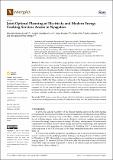| dc.contributor.author | Sánchez-Jacob, Eduardo | |
| dc.contributor.author | González-García, Andrés | |
| dc.contributor.author | Mazorra, Javier | |
| dc.contributor.author | Ciller, Pedro | |
| dc.contributor.author | Lumbreras, Julio | |
| dc.contributor.author | Pérez-Arriaga, José Ignacio | |
| dc.date.accessioned | 2022-01-21T16:18:31Z | |
| dc.date.available | 2021-10-27T18:34:14Z | |
| dc.date.available | 2022-01-21T16:18:31Z | |
| dc.date.issued | 2021-07 | |
| dc.date.submitted | 2021-06 | |
| dc.identifier.issn | 1996-1073 | |
| dc.identifier.uri | https://hdl.handle.net/1721.1/133205.2 | |
| dc.description.abstract | In 2019, there were 759 million people globally without access to electricity and 2.6 billion people lacked access to clean cooking. Cooking with electricity could contribute to achieving universal access to energy by 2030. This paper uses geospatially-based techniques—a computer model named REM, for Reference Electrification Model—to show the impact of integrating electric cooking into electrification planning. Three household scenarios were analyzed: one for providing basic electricity access with no electric cooking; another for cooking with electricity; and the third for cooking half of the meals with electricity and half with another fuel, with a clean stacking process. Results of the application of REM to the three scenarios were obtained for the Nyagatare District, Rwanda. The case study showed that electric cooking substantially changes the mix of technologies and the total cost of the least-cost electrification plan. It also showed that electric cooking can be cost competitive compared to LPG and charcoal in grid-connected households and can reduce greenhouse emissions. Stacking with energy-efficient electric appliances provides most of the benefits of full electric cooking at a lower cost and is a pathway worthy of further consideration. | en_US |
| dc.publisher | Multidisciplinary Digital Publishing Institute | en_US |
| dc.relation.isversionof | http://dx.doi.org/10.3390/en14144093 | en_US |
| dc.rights | Creative Commons Attribution | en_US |
| dc.rights.uri | https://creativecommons.org/licenses/by/4.0/ | en_US |
| dc.source | Multidisciplinary Digital Publishing Institute | en_US |
| dc.title | Joint Optimal Planning of Electricity and Modern Energy Cooking Services Access in Nyagatare | en_US |
| dc.type | Article | en_US |
| dc.identifier.citation | Energies 14 (14): 4093 (2021) | en_US |
| dc.contributor.department | Sloan School of Management | |
| dc.relation.journal | Energies | en_US |
| dc.eprint.version | Final published version | en_US |
| dc.type.uri | http://purl.org/eprint/type/JournalArticle | en_US |
| eprint.status | http://purl.org/eprint/status/PeerReviewed | en_US |
| dc.date.updated | 2021-07-08T14:22:19Z | |
| dspace.date.submission | 2021-07-08T14:22:19Z | |
| mit.license | PUBLISHER_CC | |
| mit.metadata.status | Authority Work Needed | en_US |
